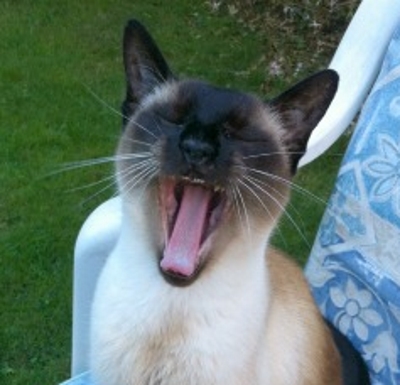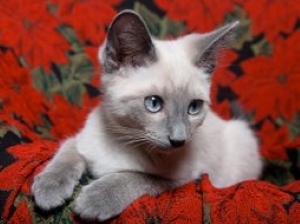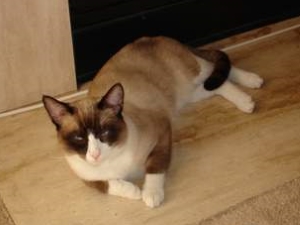- Home
- Meezer Musings
- August 2022
Meezer Musings: August 2022
How Healthy Is Your Cat?
Welcome to August's Meezer Musings!
August ... a time of ripe cornfields, and cornflowers, and poppies. Wherever you are, I hope you've had an enjoyable summer.
For many of us the end of August heralds the start of the school year and even if your schooldays (or those of your children!) are long behind you, the transition to September always seems to have a back-to-school energy, with the anticipation of autumn and the shorter, cooler days before the winter sets in.
While there's still plenty of time to enjoy the autumn days, now is a good time to make sure that our cats are as healthy as possible before the very cold weather arrives.This month we're taking a look at some simple observations you can make to ensure that your cat's in the very best of health.
You Can Tell a Lot by Looking
In October's Meezer Musings last year I wrote about the signs and symptoms of pain in cats. That article included a list of 'red flag' issues that call for an urgent vet visit, but way before either the signs of pain or the red flag issues become apparent, there are a number of ways you can spot things that may be going wrong with your cat's health.
So - is your cat a healthy cat? Let's take a look.
The Coat and Grooming
A cat's coat, whether long or short-haired, should be sleek, and softly shiny. The hairs should lie flat against one another with no spiking or clumping - an open, 'staring' coat is a sure sign of ill-health.
A healthy cat will spend a lot of time washing and grooming itself, usually after each meal, after any time outside, or contact with other animals or humans. If your cat stops grooming itself you'll need to work out why. This is a further sign of poor health and may need a vet visit for further investigation.
The Eyes
A cat's eyes should be bright, shiny and moist (and, in a Siamese cat's case, blue!) The pupil should be central, dark, and clear, and the cornea - the transparent outer layer of the eye - clear and unclouded.
You'll probably be able to see a thin crescent of white skin in the inner corner of each eye. This is the 'third eyelid' or nictitating membrane, which is often quite prominent in Siamese cats, but it should never look inflamed or swollen. Very often, inflammation of the third eyelid is one of the first signs of illness.
Get to know your own cat's eyes and inspect them regularly for any signs of change. The better you know them, the quicker you'll be able to tell if things start to go wrong.
The Ears
The ears, too, should be regularly inspected. Make sure that the outer skin and hair are smooth and unblemished with no bald patches. Hair loss may indicate fungal infections like ringworm, or other issues including allergies, mange, the presence of fleas, or ear mites.
Ear mites are quite common, but they're nasty little critters which usually show up inside the ear as a dry, reddish-brown or black discharge, often combined with an offensive smell. You may also notice excessive ear scratching and head shaking, as ear mites are very, very itchy.
The Mouth
Whenever you can (yawning is often a good time) take a look inside your cat's mouth. The lining of the mouth should be red and the tongue should look clean and even, with no sores.
 Life's Just One Big Yawn!
Life's Just One Big Yawn!Teeth should be milky white with no brownish discoloration at the edges, and gums should be pink, with no obvious signs of soreness or swelling.
While you're at it, take a sniff! One of the first signs that something's wrong in a cat's mouth is bad breath. The presence of strong or offensive odors may indicate any number of problems in the mouth, and should always be checked by a vet.
More obvious signs of poor oral health include difficulty eating, drooling, shaking or tilting of the head and pawing at the mouth, which are easy to spot and need referral to a vet, but for a simple spot check - start with the breath!
A few years ago I wrote in more detail about dental and oral health, so if you'd like more details, here's the newsletter about oral problems in cats.
Sleeping
Cats (lucky cats!) spend an enormous amount of time asleep. This varies from twelve to eighteen hours a day, with older cats tending to sleep for longer than youngsters. Cats usually sleep in naps of one to two hours, during which they may dream.
Both excessive wakefulness and excessive sleep can indicate health problems - in particular with the kidneys and thyroid - so get to know your own cat's habits well enough to be able to spot when they deviate from their usual patterns.
And while they're asleep (or otherwise relaxed and happy) take a little time to notice their heart rate and breathing.
Heart Rate and Breathing
You can feel a cat's pulse on the inside of the thigh near the groin; a healthy cat will have a pulse rate of 100 to 120 beats per minute. This is faster in kittens (120-140 bpm) and in fearful, excited or feverish cats.
Another vital sign to note is breathing. A cat's respiration rate is normally between 20-30 breaths a minute, although when asleep this will fall to 12-15 breaths.
In overweight cats, breathing rises to 30-35 breaths per minute; it also rises when a cat is ill so faster respiration may indicate health problems. It does vary, though, so get to know what's normal for your own cat.
Weight
Speaking of overweight ... Siamese cats are bred to be energetic and slender; they really shouldn't be chonky! However, Siamese cats are also extremely clever at begging food and treats, and there's a huge temptation to overfeed them.
So what is overweight? The different types of Siamese cat vary a lot in size so there's no real 'average weight' for a Siamese cat.
As a general rule of thumb, if you look down on a cat from above, there should be a visible and obvious waist behind the ribs and in front of the hind legs; if your cat appears round at that point, the likelihood is that it's overweight. A vet will be able to tell more precisely and offer advice on a diet, if necessary.
Tail End ...
A long, long, time ago before social media existed, I had several pages on this site where readers could submit their photos and stories.
Apart from a Memorials page, I closed the others some time ago for various reasons but I've been reorganizing and I've now been able to re-open a place where, if you wish, you can submit your own stories again. You'll find it here.
That's all for this month! I'll be back at the end of September and meanwhile, I hope you enjoy the beauty of the changing seasons.
Caroline
Missed a Meezer Musings? A list of previous newsletters can be found here.
Some of the articles and newsletters on this site may contain links to products I think you may enjoy. If
you purchase through these links I receive a small commission, but there's
no extra cost to you. Find out more on the Affiliates Disclosure page.
Have You Discovered Our Newsletter?
If not, why not? Subscribe to our email newsletter, Meezer Musings, to stay in touch, be the first to see new information and pages as they come out, and read the things we only talk about in the newsletter.
Learn more about it on our Newsletter Sign-Up page.





